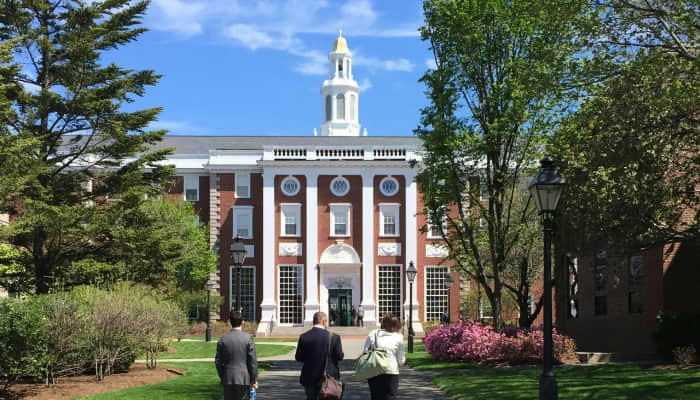Exploring Higher Education Opportunities in the United States

The United States has established itself as a preeminent leader in higher education, consistently attracting students from across the globe to its prestigious universities. Renowned for its unwavering commitment to academic excellence, the US offers a diverse range of disciplines and cutting-edge research opportunities that empower students to delve deep into their chosen fields.
Beyond academia, the US stands out for its vibrant cultural tapestry, welcoming individuals from diverse backgrounds and fostering an inclusive environment that enriches the educational journey. Moreover, the country's robust economy and extensive networks with industries provide abundant career prospects, ensuring that graduates are well-prepared to navigate the competitive global job market. This holistic approach to education makes the US a compelling destination for international students seeking not only knowledge and skills but also personal growth and lifelong connections.
1.Renowned Academic Institutions

The appeal of the United States to international students is significantly bolstered by its impressive array of world-class universities. According to the QS World University Rankings, the US is home to 62 of the top 200 universities globally, underscoring its position as a leader in higher education. These institutions are celebrated not only for their academic prestige but also for their cutting-edge research initiatives that contribute to global advancements in various fields.
Academic Excellence: Offering rigorous programs that emphasize innovation and critical thinking, preparing graduates to tackle global challenges and drive innovation.
State-of-the-Art Facilities: Providing advanced laboratories, specialized libraries, and collaborative spaces that enhance learning and research capabilities.
Global Impact: Contributing to global advancements through research, international partnerships, and initiatives in areas like sustainability, healthcare, and technology.
Community and Support: Fostering vibrant academic communities that facilitate collaboration and lifelong connections, supported by dedicated faculty and staff.
Cultural and Intellectual Environment: Serving as hubs of cultural and intellectual activity, offering diverse events and activities that broaden students' perspectives and prepare them for a globalized world.
2.Diverse Academic Programs
The United States offers an extensive range of academic programs that cater to a wide spectrum of interests and career aspirations, making it a premier destination for international students seeking educational diversity and flexibility.

STEM Disciplines: Renowned for rigorous programs in science, technology, engineering, and mathematics, with access to cutting-edge labs and industry collaborations.
Liberal Arts and Humanities: Emphasizes critical thinking and interdisciplinary approaches across fields like philosophy, literature, and social sciences.
Professional and Applied Fields: Prepares students for specific careers through programs in business, law, medicine, and fine arts, integrating practical experience.
Interdisciplinary Studies: Opportunities to customize education by combining multiple disciplines, fostering unique learning paths.
Online Learning: Increasingly available programs provide flexibility with the same academic rigor and support as on-campus options.
3.Cultural Tapestry

The United States offers international students a vibrant cultural environment conducive to personal growth and global understanding:
Diversity and Inclusion: Embracing a mosaic of cultures, US campuses provide inclusive spaces where students from around the world interact and learn from each other.
Insights and Perspectives: Immersion in this diverse society allows students to gain valuable insights into different cultures, enhancing their understanding of global issues and perspective
Networking and Connections: Students forge meaningful connections with peers from diverse backgrounds, creating a global network that spans cultures and enhances professional and personal opportunities.
Global Perspective: Experiencing cultural diversity firsthand prepares students to navigate and thrive in an interconnected world, fostering tolerance, empathy, and adaptability.
4.Pathways to Career Success
Studying in the United States enhances career opportunities for many students through:
Industry Connections: US universities maintain strong partnerships with diverse industries, providing students with access to internships and networking events that facilitate hands-on learning and industry insights.
Career Placement Services: Universities offer robust career placement services, assisting students in securing job placements with leading global corporations and entrepreneurial ventures.
Global Opportunities: Graduates benefit from a wealth of career options, leveraging their education and network connections to launch successful careers worldwide.
5.Financial Support Options

US universities provide financial assistance to international students through:
Scholarships and Grants: Offering merit-based and need-based financial aid that covers tuition, living expenses, and other costs.
Financial Aid Packages: Tailoring packages to meet diverse financial needs, ensuring students can pursue their studies with reduced financial stress.
Supporting Academic Pursuits: Alleviating financial burdens allows students to focus on academic excellence and personal development.
6.Navigating the Application Process
To successfully apply to universities in the United States, follow these steps:
Research Universities and Programs:
Explore universities that offer programs aligned with your academic interests and career goals. Consider factors like location, curriculum, faculty expertise, and research opportunities.
Fulfill Admission Requirements:
Meet admission criteria, which typically include demonstrating proficiency in English through standardized tests such as TOEFL or IELTS. Some programs may have additional requirements like GRE or GMAT scores for certain disciplines.
Compile Essential Documents:
Gather necessary documents, including:
Transcripts: Official transcripts from previous educational institutions.
Recommendation Letters: Letters from teachers, mentors, or employers highlight your academic and personal qualities.
Personal Statement: A compelling essay detailing your motivations, goals, and why you're a suitable candidate for the program.
Complete and Submit Your Application:
Fill out the university's application form accurately, ensuring all required fields are completed. Pay attention to application deadlines and submit required fees as per the university's instructions.
Await Admission Decisions:
After submitting your application, monitor your application status through the university's online portal. Admissions decisions are typically communicated within a specified timeframe.
Respond Accordingly:
Upon receiving admission offers, carefully review each offer's terms, including financial aid packages and deadlines for accepting admission. Respond promptly to secure your place in the program.
Conclusion
Studying in the US presents a wealth of opportunities for international students, encompassing top-tier education, cultural enrichment, expansive career pathways, and robust financial support. With its commitment to academic excellence and diversity, the US continues to attract students globally, reaffirming its status as a premier destination for higher education.
